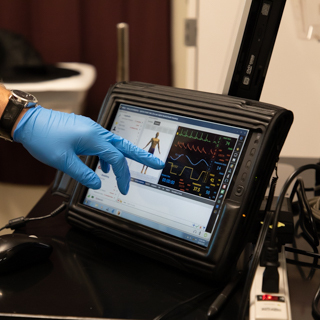Activity Classes : Aquatics
Students enrolling in courses taught at UM's Fitness and Recreation Center must present a Griz Card validating that the Campus Recreation Fee has been paid for that semester. NOTE: For all ACTivity Classes:
- There are additional Montana Board of Regents approved fees with courses that are noted with that course. Please visit the detailed course information within Cyberbear for more information.
- Grading Policy strictly enforced- classes missed prior to and after late registration count towards total absences allowed.
- Auditing of ACTivity Classes is not allowed
- For more information on Student Tuition and Fees, please visit the Business Services website.
ACT 274 - Scuba diving
Scuba diving is a mode of underwater diving where the diver uses a self-contained underwater breathing apparatus (scuba) which is completely independent of surface supply, to breathe underwater. Scuba divers carry their own source of breathing gas, usually compressed air, allowing them greater independence and freedom of movement than surface-supplied divers, and longer underwater endurance than breath-hold divers. Open circuit scuba systems discharge the breathing gas into the environment as it is exhaled, and consist of one or more diving cylinders containing breathing gas at high pressure which is supplied to the diver through a regulator. They may include additional cylinders for range extension, decompression gas or emergency breathing gas. Closed-circuit or semi-closed circuit rebreather scuba systems allow recycling of exhaled gases. The volume of gas used is reduced compared to that of open circuit, so a smaller cylinder or cylinders may be used for an equivalent dive duration. Rebreathers extend the time spent underwater compared to open circuit for the same gas consumption; they produce fewer bubbles and less noise than open circuit scuba which makes them attractive to covert military divers to avoid detection, scientific divers to avoid disturbing marine animals, and media divers to avoid bubble interference.
Scuba diving may be done recreationally or professionally in a number of applications, including scientific, military and public safety roles, but most commercial diving uses surface-supplied diving equipment when available. Scuba divers engaged in armed forces covert operations may be referred to as frogmen, combat divers or attack swimmers.
A scuba diver primarily moves underwater by using fins attached to the feet, but external propulsion can be provided by a diver propulsion vehicle, or a sled pulled from the surface. Other equipment includes a mask to improve underwater vision, exposure protection, equipment to control buoyancy, and equipment related to the specific circumstances and purpose of the dive. Some scuba divers use a snorkel when swimming on the surface. Scuba divers are trained in the procedures and skills appropriate to their level of certification by instructors affiliated to the diver certification organizations which issue these certifications. These include standard operating procedures for using the equipment and dealing with the general hazards of the underwater environment, and emergency procedures for self-help and assistance of a similarly equipped diver experiencing problems. A minimum level of fitness and health is required by most training organizations, but a higher level of fitness may be appropriate for some applications.
- ACT 274 is a Professional Association of Diving Instructors (PADI) course that teaches the mode of underwater diving where the diver uses a self-contained underwater breathing apparatus (scuba) which is completely independent of surface supply, to breathe underwater
- Prepares students for PADI certification dives
ACT 271 - Swimming
Swimming is the self-propulsion of a person through fresh or salt water, usually for recreation, sport, exercise, or survival. Locomotion is achieved through coordinated movement of the limbs, the body, or both. Humans can hold their breath underwater and undertake rudimentary locomotive swimming within weeks of birth, as an evolutionary response.
Swimming is consistently among top public recreational activities, and in some countries, swimming lessons are a compulsory part of the educational curriculum. As a formalized sport, swimming features in a range of local, national, and international competitions, including every modern Summer Olympics.
ACT 271-02 Beginner Swimming
An introduction to the basic components of fitness and competitive swimming. Students will learn water safety skills, breath control, the mechanics of the four competitive strokes, as well as drills to help with each stroke. This class is for swimmers with a basic knowledge of moving in the water (must be able to support self and move through water for 25 yards). This class is NOT for non-swimmers (no prior knowledge or experience swimming).
ACT 271-03 Advanced Swimming
A class for building and refining stroke technique, endurance, and speed for the four competitive strokes (Front Crawl, Backstroke, Breaststroke, and Butterfly). Students will work on the mechanics of each stroke, learn drills to help improve each stroke, and will swim workouts to help build technique endurance and strength. This class is for swimmers with a basic knowledge of all competitive strokes, and must be able to swim 50 yards continuously of at least 2 of the competitive strokes.
